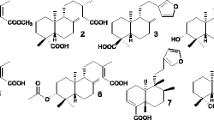Abstract
Candida sp. can cause infections of indwelling medical devices associated with biofilm formation, which are difficult to treat due to insensitivity of adherent microorganisms to host defence mechanisms and standard antimicrobial therapy. The aim of this paper was to determine the effect of EDTA (disodium salt) on the adhesion ofCandida sp. to some catheters and also on biofilm formation by the yeasts and its eradication in relation to cytotoxicity of this chelating agent to the cell cultures. The adhesion process and biofilm formation, and also EDTA cytotoxicity to green monkey kidney (GMK) cell culture were determined using MTT tetrazolium salt [3-(4,5-dimethylthiazol-2-yl) −2,5-diphenyltetrazolium bromide)] reduction assay. EDTA inhibited the growth of free-floating forms ofCandida sp. strains with minimal inhibitory concentration (MIC) from 0.06 to 0.25 mM; the minimal fungicidal concentration (MFC) values ranged from 64 to 128 mM. The prevention ofCandida sp. adhesion on the catheters used or eradication of the adherent cells was achieved at 0.5 to 4.0 mM EDTA. Also biofilm formation was prevented by 0.5 to 4.0 mM EDTA. Much higher concentration of EDTA (32 to 128 mM) was needed to eradicate the mature biofilm. EDTA at concentration up to 1 mM was not toxic for GMK cells. At higher concentration, toxicity of EDTA to GMK cells was correlated with the concentration of this agent and the time of exposure. Summing up, EDTA may be regarded as a useful agent rather in prophylaxis of candidal infections of medical devices.
Similar content being viewed by others
References
Baillie G.S., Douglas L.J. (1999).Candida biofilms and their susceptibility to antifungal agents. Method Enzymol., 310: 644–656.
Chandra J., Kuhn D.M., Mukherjee P.K., McCormick T., Ghannoum M.A. (2001). Biofilm formation by the fungal pathogenCandida albicans: development, architecture, and drug resistance. J. Bacteriol., 183: 5385–5394.
CLSI — Clinical and Laboratory Standards Institute (2002). NCCLS document M27-A2. Reference method for broth dilution antifungal susceptibility testing of yeasts; Approved standard-Second Edition, Wayne, Pennsylvania, USA.
Gil M.L., Casanova M., Martinez J.P. (1994). Changes in the cell wall glycoprotein composition ofCandida albicans associated to the inhibition of germ tube formation by EDTA. Arch. Microbiol., 161: 489–494.
Hawser S.P., Douglas L.J. (1994). Biofilm formation byCandida species on the surface of catheter materialsin vitro. Infect. Immun., 62: 915–921.
Hawser S. (1996). Comparisons of the susceptibilities of planktonic and adherentCandida albicans to antifungal agents: a modified XTT tetrazolium assay using synchronisedC. albicans cells. J. Med. Vet. Mycol., 34: 149–152.
Jabra-Rizk M.A., Falkler W.A., Meiller T.F. (2004). Fungal biofilms and drug resistance. Emerg. Infect. Dis., 10: 14–19.
Kite P., Eastwood K., Sugden S., Percival S.L. (2004). Use ofin vivo-generated biofilms from hemodialysis catheters to test the efficacy of a novel antimicrobial catheter lock for biofilm eradicationin vitro. J. Clin. Microbiol., 42: 3073–3076.
Levitz S.M., Diamond R.D. (1985). A rapid colorimetric assay of fungal viability with the tetrazolium salt MTT. J. Infect. Dis., 152: 938–944.
Lindahl M., Faris A., Wadstrom T., Hjerten S. (1981). A new test based on ‘salting out’ to measure relative surface hydrophobicity of bacterial cells. Biochim. Biophys. Acta, 677: 471–476.
Liu Y., Yang S.F., Li Y., Xu H., Qin L., Tay J.H. (2004). The influence of cell and substratum surface hydrophobicities on microbial attachment. J. Biotechnol., 110: 251–256.
Percival S.L., Kite P., Eastwood K., Murga R. (2005). Tetrasodium EDTA as a novel central venous catheter lock solution against biofilm. Infect. Control Hosp. Epidemiol., 26: 515–519.
Pujol I., Aguilar C., Fernándes-Ballart J., Guarro J. (2000). Comparison of the minimum fungicidal concentration of amphotericin B determined in filamentous fungi by macrodilution and microdilution methods. Med. Mycol., 38: 23–26.
Raad I., Buzaid A., Rhyne J., Hachem R., Darouiche R., Safar H., Albitar M., Sherertz R.J. (1997). Minocycline and ethylenediaminetetraacetate for the prevention of recurrent vascular catheter infections. Clin. Infect. Dis., 25: 149–151.
Raad I., Chatzinikolaou I., Chaiban G., Hanna H., Hachem R., Dvorak T., Cook G., Costerton W. (2003).In vitro andex vivo activities of minocycline and EDTA against microorganisms embedded in biofilm on catheter surfaces. Antimicrob. Agents Chemother., 47: 3580–3585.
Raad I., Hanna H., Dvorak T., Chaiban G., Hachem R. (2006). Optimal antimicrobial catheter lock solution, using different combination of miocycline, EDTA and 25% ethanol: rapid eradication of organisms embedded in biofilm. Antimicrob. Agents Chemother. Published online ahead of print on 30 October 2006.
Ramage G., Saville S.P., Thomas D.P., López-Ribot J.L. (2005).Candida biofilms: an update. Eukaryot. Cell, 4: 633–638.
Sen B.H., Akdeniz B.G., Denizici A.A. (2000). The effect of ethylenediamine-tetraacetic acid onCandida albicans. Oral Surg. Oral Med. Oral Pathol. Radiol. Endod., 90: 651–655.
Strevett K.A., Chen G. (2003). Microbial surface termodynamics and applications. Res. Microbiol., 154: 329–335.
Takenouchi T., Munekata E. (1998). Amyloid beta-peptideinduced inhibition of MTT reduction in PC12h and C1300 neuroblastoma cells: effect of nitroprusside. Peptides, 19: 365–372.
Author information
Authors and Affiliations
Corresponding author
Rights and permissions
About this article
Cite this article
Chudzik, B., Malm, A., Rautar, B. et al. In vitro inhibitory activity of EDTA against planktonic and adherent cells ofCandida sp.. Ann. Microbiol. 57, 115–119 (2007). https://doi.org/10.1007/BF03175059
Received:
Accepted:
Issue Date:
DOI: https://doi.org/10.1007/BF03175059




